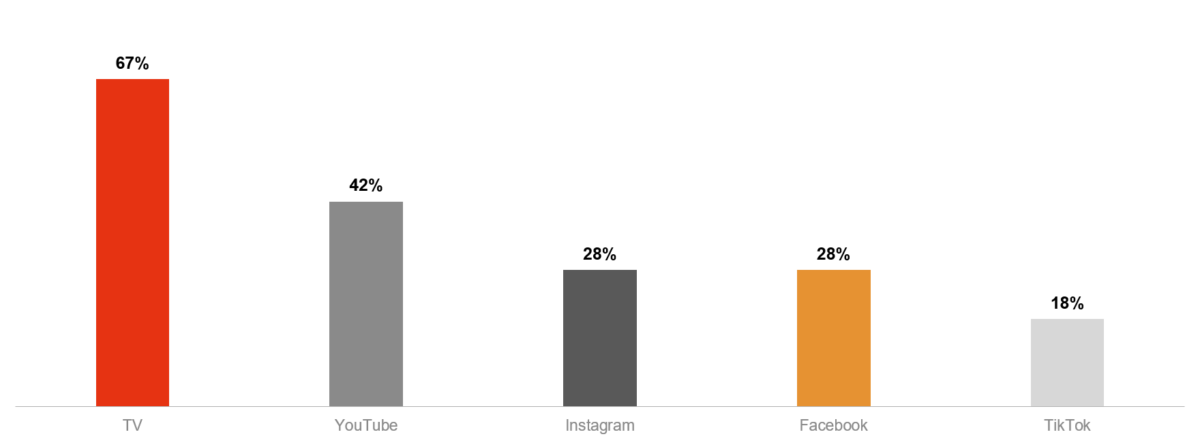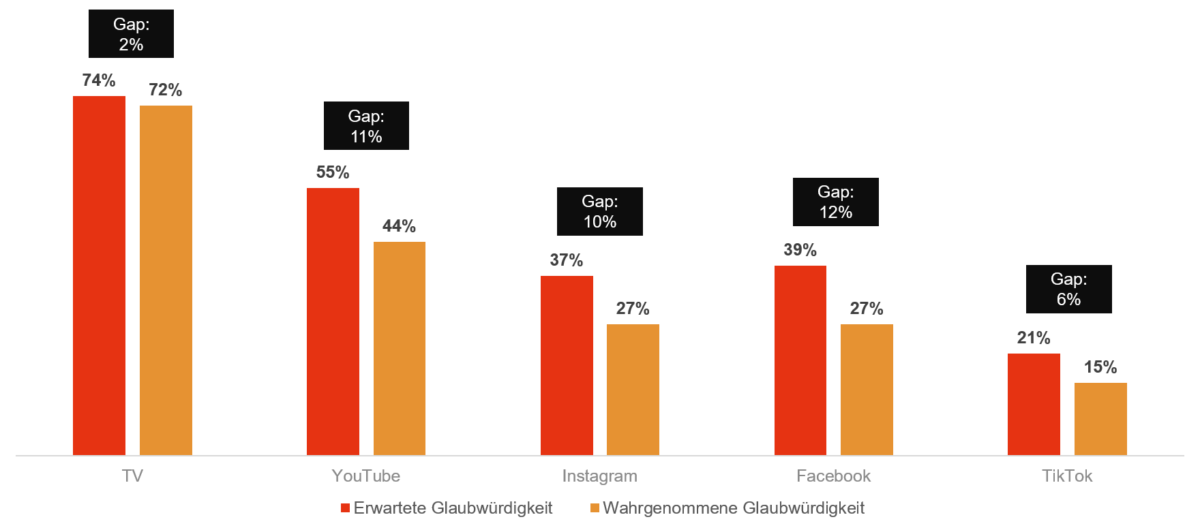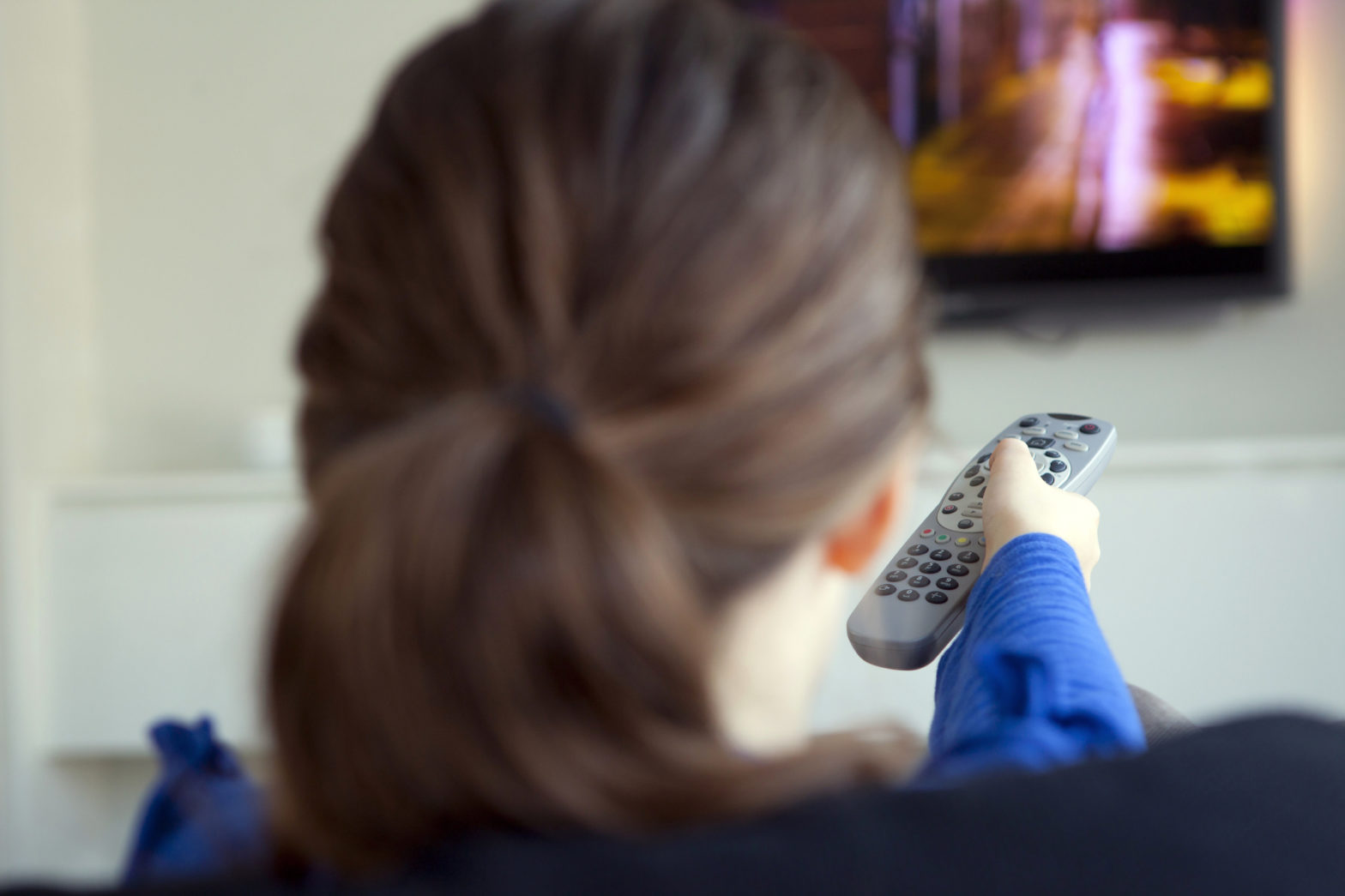The study was presented and developed by the Insight Institute, over 1000 respondents were surveyed online and 30 by phone. Based on the results of the study, Screenforce Switzerland, on behalf of the Association of Television Advertising Switzerland (AGFS), has determined a credibility factor that allows us to apply the results of the study in practice.
At the Screenforce Day on 24 May, the Insight Institute (market research institute) presented the latest study created for the commissioning company Screenforce Switzerland. In more than 1,000 quantitative online surveys and 30 in-depth one-hour interviews between February and March this year, the Institute asked about the trustworthiness of TV, YouTube, Instagram, Facebook and TikTok and advertising on these channels.
Interviewees were asked to indicate how trustworthy they perceived both the channel and the advertising on the channel, and how trustworthy the channel was to them. The results were summarised not only in terms of expectations and perceptions, but also in terms of the so-called credibility gap, i.e. the difference between what is expected and what is perceived. In order to measure credibility, the Institute surveyed the pluses and barriers in the credibility of each channel. This included 16 aspects of credibility (8 for the channel and 8 for the ad), which crystallised from the in-depth interviews and which respondents identified and ranked in order of relevance.
TV RANKS FIRST IN ALL 16 ASPECTS OF TRUSTWORTHINESS
The results speak clearly in favour of television. Both expected (74%) and perceived (72%) credibility are highest for the oldest of the five channels that interviewees were asked about. The same is true for TV advertising (67% perceived credibility). Thus, the TV channel was rated as one third more trustworthy than YouTube (55% expected / 44% perceived). Visibly on the tail are social media platforms, which did not even gain 30% perceived trustworthiness.

The same is repeated for advertising, where TV also leads, as well as for aspects of trustworthiness, where TV performed best for all 16, in some places by as much as 20%.

Based on the results of the study, Screenforce Switzerland surveyed the credibility factor on behalf of the Association of Television Advertising Switzerland (AGFS). The factor is intended to enable the results of the study to be applied in practice. For this purpose, Screenforce Switzerland created 16 aspects of credibility and their relevance, so that the credibility factor could be determined between the different channels. In this way, for example, the following result can be obtained: a contact on TV is 1.56 times more trustworthy than a contact on YouTube.

MOST IMPORTANT RESULTS:
Both TV as a channel and TV advertising get the highest trustworthiness
- With a result of 72%, the trustworthiness of TV was estimated to be significantly higher than that of YouTube (44%), Instagram and Facebook (both 27%) and TikTok (15%)
- The trustworthiness of TV advertising is also the highest with a score of 67%. This is followed by YouTube with 42%, then Instagram and Facebook with 28% each and finally TikTok (18%)
Ad retention is highest for TV
- Similarly to credibility, TV has the highest ad retention rate (57%). YouTube follows with 44%, Instagram (33%), Facebook (28%) und TikTok (17%)
TV with the smallest credibility gap
- With an expected credibility of up to 74 %, the credibility gap for TV is clearly the smallest (2 %)
- For YouTube, the expected credibility was 55%, corresponding to a credibility gap of 11%. For Facebook, the expected trustworthiness was 39% and the gap was 12%. This is followed by Instagram with 37% and a gap of 10%
- For TikTok, the credibility gap of 6% is slightly smaller. However, this was due to the fact that respondents estimated the credibility of the channel to be very low from the beginning (21%)
TV WITH THE MOST PLUSES AND LEAST BARRIERS
Positives and barriers for TV
+ Assumption of trust - we have known TV for the longest time
+ Reputable institutions - Stations like SRF, ARD, ORF etc. are trusted by people
+ Valuable content - People trust news, documentaries, information programmes etc.
+ Security - Less concern about data protection
+ Method of advertising - TV advertising is well and professionally produced and expensive and therefore of high quality
- Unrealistic promises - e.g. for example, a detergent is dragged through dirt and still cleans everything
- Homogeneity - many ads for the same product with the same message
Positives and obstacles on YouTube
+ Valuable content - People trust guides, recipes, etc.
+ Method of advertising - See TV
+ Institutional associations - People know there are trusted institutions on YouTube, which builds trust
+ Security - People don't trust Google on data protection
- Questionable content - People are skeptical of YouTube advertising
- Method of advertising - many questionable ads (millionaire in two weeks)
The pros and cons of social networks
+ Known influencers - People trust influencers who have been suggested to them
+ Realistic Comments and Likes - If an ad or post has realistic comments, credibility grows
- Security - Fear of data theft, questionable links, etc.
- Questionable content - People already know about fake news on social media. Anyone can post whatever they want
- Manipulative algorithms - People know about the algorithms that are applied to advertising on social media
- Manner of advertising - poor quality advertising with grammatical errors, out of focus, etc.
ALSO ON THE CREDIBILITY ASPECTS, TV IS IN THE LEAD
Credibility aspect for each channel
- The channel has been around for a long time (TV 77%, YouTube 55%, Facebook 44%, Instagram 39%, TikTok 25%)
- Consistently high quality (77% / 58% / 44% / 33%)
- Valuable content (73% / 42% / 30% / 28% / 19%)
- Editorial accountability (70% / 38% / 26% / 21%)
- Based in Europe/Switzerland (68% / 30% / 25% / 27% / 18%)
- Separation of content from advertising (66% / 42% / 32% / 30% / 22%)
- High security requirements (62% / 36% / 27% / 27% / 20%)
- High data protection requirements (61% / 35% / 27% / 26% / 20%)
Credibility aspect of advertising
- The advertisement features products available in Switzerland (77% / 49% / 47% / 36% / 22%)
- Advertising of trusted brands (71% / 45% / 32% / 20%)
- Advertising with appealing visuals (68% / 51% / 36% / 40% / 26%)
- Advertising with a good concept (62% / 43% / 29% / 30% / 23%)
- Realistic promises (60% / 40% / 29% / 29% / 19%)
- It is known when the ad will run (60% / 52% / 33% / 30% / 21%)
- Anyone (any advertiser) cannot run the ad (59% / 34% / 27% / 27% / 21%)
- Not very high frequency of advertising (46% / 35% / 34% / 32% / 26%)
More information:
Simone Schulz, Screenforce Switzerland Management
079 653 12 61
info@screenforce.ch
ABOUT SCREENFORCE
Screenforce is an initiative of the television stations in the DACH region. The alliance consists of 12 TV marketers for TV and motion cast and represents 95% of the TV advertising market in Germany, Austria and Switzerland. In Switzerland, Screenforce is operated by the Association of Television Advertising Switzerland (AGFS). This group is the result of a collaboration between the national marketers Admeira, CH Media, Goldbach Media and the interest group for electronic media (IGEM).
Source: screenforce.ch

